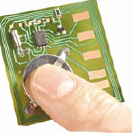April 18, 2003 – Billions of dollars are spent each year on medical research. But evaluating the drugs designed in laboratories around the world is an imprecise science. Two pharmaceutical companies are now testing a new blister packaging system that records when people take medication and sends that information to readers using radio frequency identification technology.
Information Mediary Corp. (IMC) and Shorewood Packaging, a business of International Paper, developed the smart packaging technology. IMC CEO Michael Peterson declined to reveal the names of the two pharmaceutical companies at this time, but said the trials are expected to be completed next month.
About 40 percent of patients don’t take their medication as prescribed, according to IMC. In clinical trials, that can make it difficult to determine the effectiveness of some drugs that must be taken at specific intervals. The new Med-ic ECM (for Electronic Compliance Monitor) is designed to solve the problem.
The smart packaging combines IMC’s “sensor grid technology” and a proprietary process of printed conductive inks. When a patent breaks open the blister packages — individual foil wrappers for pills — a signal is sent to a microprocessor that records the date and time.
IMC says the Med-ic ECM packaging can be tailored to specific clinical requirements, such as monitoring the temperature, vibration, humidity, radiation, light or shock to which the package might be exposed. The company could also add beeps or a tiny light to alert the patient when it is time to take a pill.
IMC currently uses a microprocessor from Microchip Technology and forgoes the use of a separate RFID chip. The company enhanced the processor by embedding firmware with an RF capability. The chip can store up to 1 kilobyte of data and acts like a standard RFID 13.56 MHz frequency chip.
Peterson says that saves the 50 cents to $1.00 the company would have to pay to embed an RFID chip in the packaging. The data is broken down so that it looks as though it’s a standard RFID transmission. The data is then reconstituted when the doctor or clinician uses the reader.
The reader also uses technology from Microchip but Peterson says he’s looking to create a new reader based on a Texas Instruments microprocessor. That’s because the Microchip reader is analog, but the TI chip would allow them to create a digital reader, for an easier and more accurate reading.
Shorewood will manufacture and distribute the IMC technology. IMC is not the only company pursuing this market. Cypak, a Swedish startup, has developed a low-cost, RFID-like system for embedding intelligence in blister packaging. (see The Package Is the Computer).
Peterson hopes to take the technology beyond pharmaceutical packaging. He says he would like to see it used to print tamper-evident lids on cardboard packaging to detect intrusion. “It would be a means of communicating data so that we don’t have to remove the chip from the package to read it,” he says.


